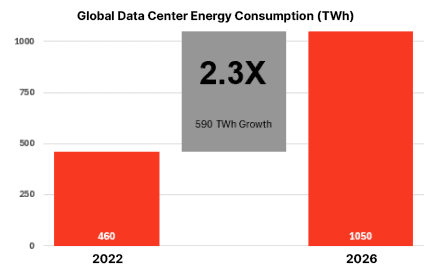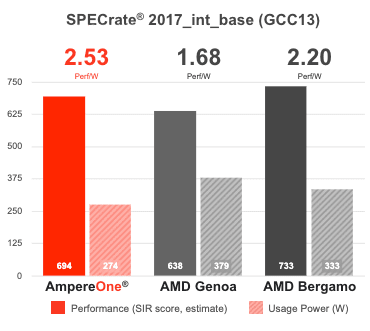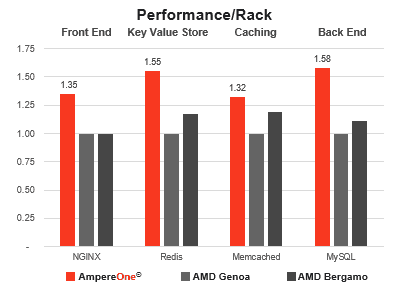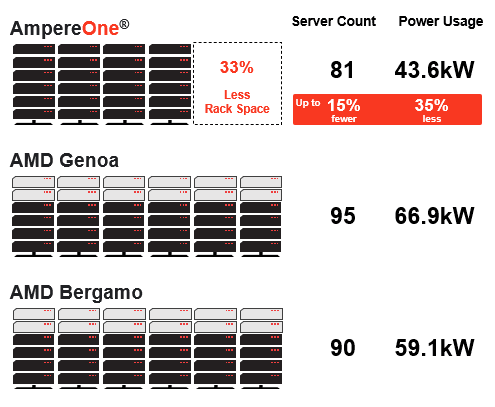Combat High Energy Consumption with AmpereOne®

In our 2024 Annual Roadmap Update, CEO Renée James and CPO Jeff Wittich highlighted how AmpereOne® is designed to curb rapidly rising energy needs.
We need to act now to reduce power.
Customers lament weekly about racks and data centers that are only partially full because power budgets are exhausted. Surges in AI adoption and the relentless expansion of compute-intensive industries are just some of the factors ramping power consumption. Data centers are on pace to double energy use by 2026 from 2022 levels. No doubt, power consumption remains the most critical factor in the continued growth of compute at the edge and in the cloud.

Simply put, demand could outstrip the supply in years to come.
There is a solution.
Ampere’s Cloud Native Processors are the answer. AmpereOne is our latest energy-efficient processor, building upon the continued success of the Ampere® Altra® family. It is the best choice for data center modernization. Reclaim data center space, improve performance and productivity, and make room to introduce innovation.
Building on our solid design principles, we improve both density and efficiency with new processor introductions. Compared to the Ampere Altra family, AmpereOne packs up to 50% more cores per socket and delivers nearly twice the SPECrate® 2017_int_base performance. Sure, usage power has gone up slightly, but at a much lower clip. You get 29% better performance per core and 26% more performance per watt. You get the most efficient Cloud Native Processor yet.
Compared to AMD EPYC (Genoa and Bergamo), the quasi-performance leader of x86 server processors, AmpereOne delivers. The AmpereOne A192-32X with 192 single-threaded 3.2GHz cores running at 3.2GHz provides:
- 10% better performance and 50% better performance per watt over 96 core AMD Genoa 9654
- 15% more performance per watt than 128 core AMD Bergamo 9754

We deliver at scale.
The real impacts we make become undeniable as services run at scale. Performance per rack incorporates inherent power and space constraints much better than single system performance. It’s a more useful metric to gauge compute efficiency. According to the Uptime Institute, a vast majority of modern datacenters operate in under 20kW per rack1. We look at a 42U rack with 12.5kW, allocating 2U and 1.0kW for overhead. Server power draw is calculated by adding component power for memory, storage, networking and miscellaneous to CPU power. Then, we determine how many servers we can pack into a rack (given power and space constraints) and multiply with server-level performance.
What do we get?
- 34% better performance per rack than Genoa
- 10% better performance per rack than Bergamo
AmpereOne is the efficiency leader. Period.
Synthetic benchmarks are useful to characterize compute-intensive performance. They usually do not hit home with most operators, though. So, we add real-world context and analyzed some of the most popular cloud native web service workloads. We used the same methodology: dividing CPU performance by power draw under load. The results are then normalized (AMD Genoa is the baseline). NGINX is used for web front end, Redis as the key value store, Memcached for in-memory caching and MySQL as the backend.

The results: AmpereOne Cloud Native Processors lead in performance efficiency by as much as 1.9X for some of the most common container applications.
Let’s also scale those CPU metrics to the rack level to demonstrate the impacts at scale. It’s simple. Lower CPU power draw allows more servers to run in a rack. You get less wasted rack space, better TCO, and improved total rack performance. Compared to AMD Genoa, the performance per rack advantage is a high as 58%.

Imagine deploying four full racks of AmpereOne, each dedicated to hosting one of the four containerized web services applications. To achieve the same workload throughput on AMD Genoa or Bergamo, 23.3kW and 15.5kW more are required respectively. At 12.5kW per rack, an AMD-based deployment requires two additional racks. Also, as many as 14 additional servers are needed to match performance — a huge driver of CapEx and OpEx.

Don’t wait to refresh.
Data center operators with infrastructure older than five years are faced with serious decisions when it comes to refresh. Costly data center overhauls or buildouts (if even an option) to add power or exotic cooling solutions should be avoided.
Let’s draw on the earlier example. You are an IT operator running your regional fintech operation on 6 racks with aging servers. You could replace with AMD EPYC. Whether you land on Genoa or Bergamo, either way, the machines will hog around 650-700W limiting your ability to fully utilize each rack. You’d manage to stay within your power and rack constraints and could probably get it approved by your CFO. Voilà.
However, what might seem like a sound decision is wasteful. Racks end up with unused space, yet you have no power left to accommodate business growth.
Choose Ampere. Do the same work with just four racks. Reduce CapEx by buying up to 14 (21%) fewer servers. Cut OpEx by saving up to 41% on power consumption. Reclaim those savings. Repurpose them. Grow and innovate your business such as through the adoption of AI to build more efficient, scalable and personalized products for your customers.
This is your opportunity. Modernize with AmpereOne

Now what?
We are on a mission. Now is the time to innovate. AmpereOne continues to carry forward Ampere’s performance efficiency leadership, outpacing AMD by up to 50% performance per watt and up to 34% performance per rack. Start reclaiming and repurposing budget, power, and rack space toward innovating your stack. Refresh your old infrastructure to cloud native servers and services with Ampere.
Make the world a better place by shrinking carbon footprint and driving toward achievement of your sustainability goals.

1 Uptime Institute, Global Data Center Survey 2023
Contact us today or join our Ampere Developer Community.
